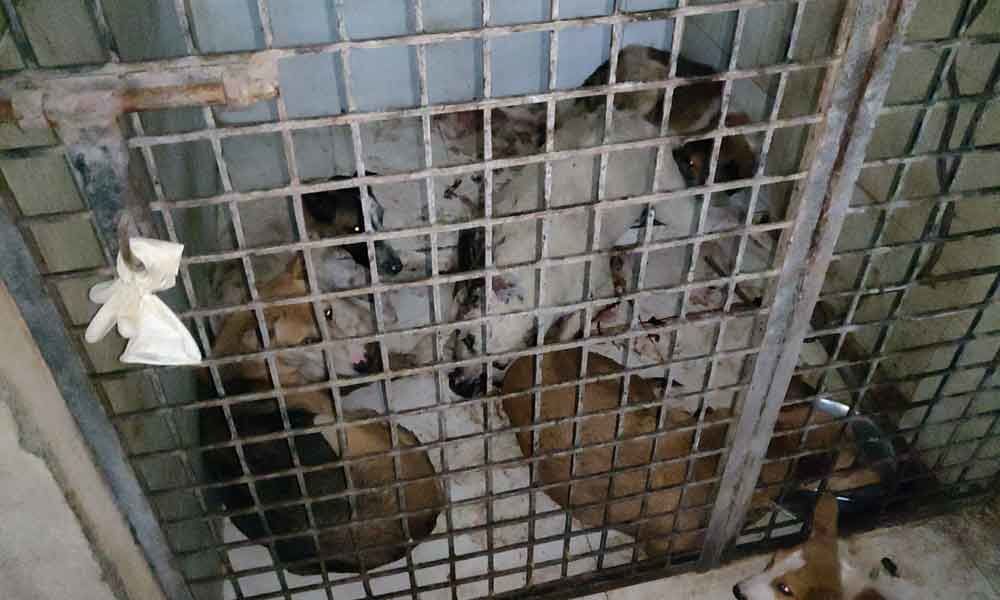Live
- ‘Dilruba’ team comes with first single ‘Aggipulle’ unveiled
- Legal drama ‘Court - State vs A Nobody’ set for March release
- Priyadarshi’s ‘Premante’ gets announced with grand launch
- Minister Jupally Reviews Rythu Bharosa Scheme Implementation in Nizamabad
- Wanaparthy collector reviews on survey of welfare schemes
- NDRF, NDA always come to rescue in case of disasters
- ‘Bhairavam’ teaser is just around the corner
- ‘Shiva Sambho’ blends culture and devotion in Telugu cinema
- Akash Jagannadh extends generous support to veteran Actress Pavala Syamala
- 'Attack' on Kejriwal: Atishi claims BJP wants to harm ex-CM, Parvesh hits back
Just In
Animal Birth Control centres for strays in city going to the dogs


Dozens of dogs are brought to the pound every day and cages keep filling up. The GHMC builds up numbers that they are operating on dogs and releasing them but the dogs are not being released where they are rounded up.
Amberpet: Dozens of dogs are brought to the pound every day and cages keep filling up. The GHMC builds up numbers that they are operating on dogs and releasing them but the dogs are not being released where they are rounded up.
The dog pound which is now known as Animal Birth Control (ABC) centre is supposed to be a boon for stray dogs but in stark reality, the authorities are eating up all the money that is needed to be spent for dogs and instead of culling them. "The condition at the dog pound is horrible.
There are 5 to 6 dogs kept in a kennel which is meant for two dogs. They are not given food and water; besides, the kennel is never cleaned. In each kennel, you will see at least one dead dog. They don't have a proper record or paperwork of the dogs on the place where they were picked up. The dogs which were brought in for ABC surgeries either die here or two-three days later when they are sent back to their areas from where they were picked," alleges Shreya Paropkari of Humane Society International (HIS) India.
Earlier, the ABC programme used to be carried in collaboration between BlueCross and the government, but the GHMC never reimbursed the organisation for money, thereby making the organisation back off from supporting GHMC to run the ABC programme successfully. GHMC has five dog pounds in Hyderabad at Amberpet, Autonagar, Jeedimetla, Patancheru and Zumerath Bazar.
History of programme
Before 2001, stray dogs were being culled on a daily basis in majority parts of our country because of increasing incidences of dog bites. But, the population issue of stray dogs continued to persist and it came to the attention of the World Health Organisation (WHO) whose officials researched about why developing countries like India, Sri Lanka and Bangladesh could not control stray dog population, even after a thorough dog culling programme. On conclusion of their research, the WHO came to a scientific conclusion that the dog population is directly proportional to the carrying capacity of a particular area and amount of food the dogs get from a particular area.
What led to spurt in dog bites
When a dog was being taken from a territory, other dogs fight for his territory and in this chaos, people get bitten. During mating season, dogs fight to be the righteous partner and in this adrenalin situation if a human being passes by he becomes the butt of their anger. Dog bites are also reported when a mother gets aggressive in protecting her puppies.
Finally, the WHO arrived at the conclusion that the solution to the increase in stray population is to an Animal Birth Programme (ABC) which carried out sterilization on the dogs, both male and female. This is seen to pave for decrease not only in dog numbers and but also attacks on humans.

© 2025 Hyderabad Media House Limited/The Hans India. All rights reserved. Powered by hocalwire.com






